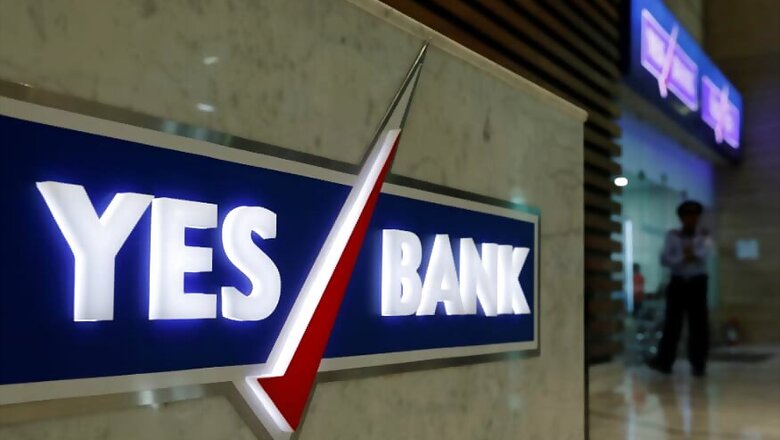
views
Mumbai: Yes Bank expects pressures from sour loans, which led it to declare the highest loss for any private sector lender at Rs 18,654 crore for the December quarter, to continue even in FY21, but CEO-designate Prashant Kumar is confident of its survival after a Rs 10,000-crore capital infusion.
The bank witnessed withdrawals of over Rs 72,000 crore of deposits in the last six months to Rs 1.37 lakh crore, but the Rs 10,000 crore capital infusion, coupled with over 1,000 branches and a strong customer base makes Kumar confident of Yes Bank continuing to be a "going concern".
"The proposed capital infusion and the bank's strong customer base and branch network will enable the Bank to continue its business for the foreseeable future, so as to be able to realise its assets and discharge its liabilities in its normal course of business," the bank said, quoting Kumar's assessment.
Kumar is at present the bank's RBI-appointed administrator and will be taking over as CEO on Wednesday evening once the bank comes out of moratorium.
The heavy reverses on corporate lending — nearly a third of the overall loans have turned sour — have probably led the new management led by Kumar to earmark focus on retail and small business loans as a priority going forward, according to its investor presentation.
The bank has also made it clear that additional-tier 1 bonds of over Rs 8,500 crore will have to be written-down completely for the reconstruction to begin, setting the stage for a legal battle.
Kumar had to be installed as the administrator of the bank on March 5 by the RBI, after the government superseded its board due to an inability to raise much-needed capital.
Much of the troubles at the bank are attributed to the alleged mishandling by its co-founder and former chief executive Rana Kapoor, whose term was cut short by the RBI due to governance lapses.
Under Kapoor's successor Ravneet Gill, it began an accelerated recognition of the stress hidden in the balance sheet, which started with reporting its maiden quarterly loss in March 2019.
Kumar has continued the widely prevalent practice of an incoming head cleaning up the books and preferring to start with a clean slate.
However, in its investor presentation, Yes Bank said slippages, which went up to Rs 24,587 crore in the December quarter, will normalise only in FY22.
The bank told investors that it expects slippages to be at 5 per cent of the assets in FY21. The assets decreased by 22 per cent to Rs 2.90 lakh crore at the end of December 2019, as compared to the year-ago period.
Compared to the preceding quarter, advances overdue for 31 to 90 days (levels before they get tagged as NPAs), declined 43 per cent to Rs 13,911 crore.
The higher slippages and a reduction in loan book were key reasons for the 60 per cent decline in the core net interest income at Rs 1,065 crore, and also narrowing of the net interest margin to 1.4 per cent from 3.3 per cent a year ago.
Deposit mobilisation, accelerating resolution of the stressed assets and cost optimisation have been marked as the key focus areas, along with a shift to low-value loans by Kumar.
In the high-value loans segment, the strategy is to reduce exposure to commercial realty, non-bank lenders, housing finance companies, infrastructure and electricity sectors, it said.
Meanwhile, the bank's reconstruction has been set-off with the issue of Rs 10,000 crore of shares to the consortium led by SBI, which also includes IDFC First Bank, Bandhan Bank, Federal Bank, ICICI Bank, HDFC, Kotak Mahindra Bank and Axis Bank, the bank informed the exchanges.
The capital infusion of Rs 10,000 crore along with the writedown of the bonds will ensure that the common equity tier-I capital ratio will move to 7.6 per cent from 0.6 per cent in December 2019, and also above the regulatory mandated 7.375 per cent, the bank said.
On the contentious issue of the fate of the additional tier-I bond holders, who are staring Rs 8,500 crore of holdings being written down, there was no good news in the bank's late night communiques to the exchanges, even as auditors suggested the money can be handy amid the extremely low capital buffers.
Kumar said the relevant section of the Banking Regulation Act has been invoked by the RBI and the scheme has been notified, wherein the bank is "deemed to be non-viable or approaching non-viability".
"Accordingly, the triggers for a write-down of certain Basel III additional tier 1 Bonds ("AT 1 Bonds") issued by the Bank has been triggered. Such AT-1 Bonds would need to be fully written down permanently before any reconstruction of the Bank is undertaken," he made it clear.




















Comments
0 comment